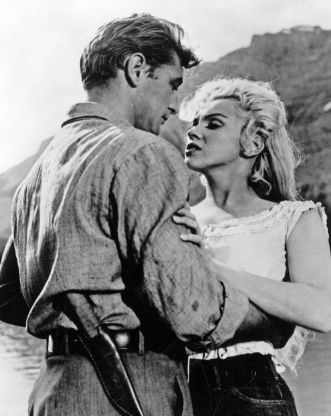
The Western Films of Robert Mitchum, a new book by Gene Freese, focuses on the actor’s many roles as ‘Hollywood’s cowboy rebel’ from the 1940s-70s, including his collaboration with Marilyn.

“River of No Return opposite iconic sex symbol Monroe is one of Mitchum’s most popular and enduring titles, not a classic by any means but an entertaining, entirely pleasant and colourful film to view. It was a 20th Century Fox loan-out, shot in CinemaScope and stereophonic sound in the heart of the Canadian Rockies … Otto Preminger was an odd choice to direct the picture. It was his sole Western.
Regarding his chemistry with Monroe, the film relies on their growing desire for one another as they begin to see the other in a different light. That wasn’t good enough for Fox executive Darryl F. Zanuck, who requested that Preminger add a body massage and an aggressive kissing scene that appears out of character for the extremely laid-back Mitchum … Already out of his element on the film and on to another project, Preminger refused to film the scene. Director Jean Negulesco helmed the footage of physical contact between the two stars in the late fall of 1953 … ‘She actually bit me in our little wrestle scene,’ Mitchum said. ‘I didn’t mind it.’
Monroe was impressed by Mitchum and talked of their passionate embrace in the film’s pressbook: ‘This is a brand new experience for me. I have never had a romantic love scene with a rugged he-man. It’s quite enjoyable’ … Monroe was happy for the opportunity to wear shoes on the film due to Mitchum’s height. She usually had to go barefoot because of being paired with short male co-stars, but Mitchum towered above her throughout. She expounded on Mitchum in the pressbook, revealing, ‘He’s one of the most fascinating men I’ve ever met. He’s a man’s man, the outdoor he-man type, but he possesses a great inner strength … I had always heard he was one of the nicest guys in the business. It was wonderful to discover that the legend was not only true – but an understatement.’
Mitchum had known Marilyn Monroe back when she was a teenager named Norma Jeane Baker and married to his Lockheed pal Jim Dougherty … Fox no doubt wanted to play up the smouldering physical attraction between sex symbols Mitchum and Monroe, but for some of the filming Monroe’s baseball player boyfriend Joe DiMaggio was present. Mitchum maintained that he never found Monroe sexy despite her screen image. To him, she was a sad and confused soul.
If 20th Century-Fox was unable to play up a love affair between the two stars, they could emphasise the dangers of the location … At one point on the river, Monroe’s wading boots filled up with water and Mitchum had to rescue her from drowning, to the delight of the publicists. On another occasion, the stars were on a raft that became lodged on the rapids after a safety cable snapped. Stuntman Norman Bishop had to go out in a lifeboat and rescue the actors … but Monroe wouldn’t get on the boat unless the ill Mitchum did at the same time. Publicists again attributed the rescue to Mitchum. Finally, Monroe slipped on a stone in the riverbank and sprained an ankle. When she was outfitted with a leg cast, Mitchum started calling her Hopalong.
Back in Hollywood, the film’s action was redone in close-up with the principals in a studio water tank … Mitchum played up the CinemaScope danger for the press, saying, ‘… I’ve done things in this picture which would give some stuntmen the shivers. The amazing thing is how Marilyn and Tommy Rettig, who plays my son, have done them … I was so struck with admiration for my two companions. I almost forgot to be frightened for myself …’
Feeling that Monroe had a personality that was too fragile for Hollywood, Mitchum tried to look out for her in other ways. The greatest hurdle for Monroe to overcome on the film was a constant reliance on instruction and positive analysis from acting coach Natasha Lytess … As Preminger and the studio-approved Lytess were at great odds, Mitchum and assistant director Paul Helmick became go-betweens for Monroe and the director … Throughout the extended delays, [Mitchum] tended to drink, even wandering off for a beer with the locals at times …
‘She was very shy, very pleasant, very sweet,’ Mitchum said of Monroe in a 1980s WEDU TV interview. He continued: ‘But she was not too comfortable around people because I suppose her background had not prepared her for sort of easy sociality. She was convinced that she was not terribly pretty or sexy … At that time, I didn’t think she knew too many people who were very friendly to her. Growing up in that atmosphere of agents, directors and journalists, she seemed like a lost child … Her position in this atmosphere was like Alice in Wonderland. The whole thing was through the looking glass and she could not believe that anyone was very serious about her.'”
